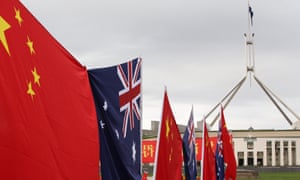New data out on Chinese investment in Australia has revealed that while the mining industry is the dominant destination of funds, investment in real estate and transport infrastructure also accounts for a large proportion of Chinese activity. And while most of the investment projects are by privately owned companies, the data reveals that state-owned enterprises account for nearly half of the value of investment due to their purchase of large-scale projects.
The new data by the East Asian Bureau of Economic Research at the Crawford School of Public Policy at the Australian National University has found that in the four years from 2014 through to 2017, just over $40.4bn worth of direct investment in Australia came from Chinese-owned companies.
The figures show that 2016 was the peak recent year, with 2017 seeing a 40% fall in Chinese investment:
Surprisingly New South Wales is the biggest recipient of Chinese investment, with more than $15bn worth over the four years. But this is somewhat skewed because investment for mining, for example, while it might occur in Western Australia or Queensland, is recorded as being in NSW if that is where the company is registered:
South Australia’s biggest year was in 2016, due mostly to the Chinese private gas distributor ENN buying a large stake in Santos.
The data, which goes into more detail than that provided by the ABS or Foreign Investment Review Board, highlights that the level of investment from China can be subject to large variations due to massive investments in certain projects.
Mining is the major industry receiving Chinese investment. From 2014-17 it received $9.9bn worth of investment, with real estate coming in second with $8.7bn:
But far and away the largest number of projects involving Chinese direct investment are in the real estate industry – 110 such projects received Chinese investment compared with 36 mining projects.
Not surprisingly this is because the opportunities for investing in real estate are much greater than in mining and mining is also a much more expensive operation on a per-project basis.
And mostly here we are talking about commercial real estate rather than residential. In 2015, which was the year that saw the largest amount of investment in real estate with just over $4.5bn, only $84.5m was for residential sites, and the largest single investment was the purchase of Investa Office Portfolio’s nine office towers by the Chinese sovereign wealth fund China Investment Corporation (CIC):
So large was that purchase that it alone was nearly double the value of the total investment in real estate by Chinese companies in 2017.
Other large irregular investments occurred in 2016, such as the purchase of the Port of Melbourne by investors including CIC, and the purchase of Pacific Hydro by the state-owned State Power Investment Corporation.
Both of these purchases saw the highest level of investment in both the transport and electricity industries over the four years – indeed in 2017 there was no Chinese investment in the transport industry at all.
Healthcare can also see large increases in investment numbers, such as when Ansell Sexual Wellness business was purchased in 2017 and in 2016 when a China state-owned company bought healthcare company GensisCare.
The data also sheds some light on the investment strategies of state-owned enterprises. It found that of the 234 projects over the four years that listed a parent company, only 15% were state-owned. This would suggest that concerns about state-owned entities buying up large amounts of infrastructure or companies in Australia are overblown. But when the figures are broken down according to value, a clearer picture emerges.
Just over $19bn (47%) of the $40.4bn worth of Chinese investment came from companies with a state-owned parent company:
These state-owned enterprises are much more likely to make large investments – such as the Port of Melbourne or Pacific Hydro – whereas the private companies are more likely to make smaller purchases, especially in real estate or accommodation, such as the purchase of Daydream Island in 2015.
The data also shows that most Chinese investment occurs in large-scale projects, with more than 40% of the projects involving more than $51m, and 87% of the total value of investment is from projects with a more than $100m worth of investment:
This data gives us some very detailed insight into Chinese investment. As Philip Gaetjens, the new secretary to the Treasury, noted on Monday in a speech to the Chinese Investment and Australia Forum, while “the stock of Chinese direct investment in Australia was still only 4.8% of the total” value of foreign direct investment in Australia, it is a growing segment. For the past three years, China has been the largest source of proposed foreign investment – accounting for nearly 25% of all proposed investment in 2016-17.
As such, it is valuable to keep a track of where the money is going, and where it comes from. And while often the concerns about Chinese investment are more political than economic, the large investments by state-owned enterprises highlight that a very great amount of business with China is driven not so much by private enterprise but by a government whose aim may not only be commercial profit.
Source : https://www.theguardian.com/business/commentisfree/2018/oct/09/following-the-money-where-chinas-40bn-investment-in-australia-is-going

